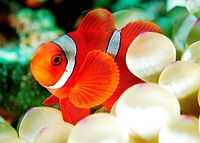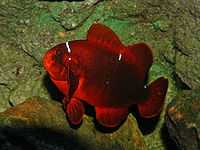Maroon clownfish
| Maroon clownfish | |
|---|---|
.jpg) | |
| Scientific classification | |
| Kingdom: | Animalia |
| Phylum: | Chordata |
| Class: | Actinopterygii |
| Order: | Perciformes |
| Family: | Pomacentridae |
| Subfamily: | Amphiprioninae |
| Genus: | Premnas Cuvier, 1816 |
| Species: | P. biaculeatus |
| Binomial name | |
| Premnas biaculeatus (Bloch, 1790)[1] | |
| Synonyms | |
|
Chaetodon biaculeatus Bloch, 1790 | |
The maroon clownfish, Premnas biaculeatus, is a species of clownfish that is found in the Indo-Pacific from western Indonesia to Taiwan and the Great Barrier Reef.[2] They can grow up to be about 17 centimetres (6.7 in),[3] and as they grow, they become more aggressive towards other clownfish. It is also known as the spine-cheeked clownfish. It is the only member of the genus Premnas,[3] although it has been suggested that the taxon epigrammata from Sumatra should be recognized as a distinct species, Premnas epigrammata (Fowler, 1904).[4]
The stripes across the body are normally white, but they are yellow in the taxon epigrammata. The female is dark red or maroon, while the smaller male is brighter orange-red.[3][4]
In the wild, the fish's only host is the bubble-tip anemone (Entacmaea quadricolor).[3] The fish's natural diet includes algae and zooplankton.[3]
Description
Maroon clownfish are maroon in colour. Females of this species are larger than males.[3] Females can grow up to 17 centimetres (6.7 in).
In the aquarium
Many hobbyists believe that a 115-litre (30 US gal) tank is best for one fish or 230 litres (61 US gal) for a pair. In the wild, it is strictly associated with the sea anemone Entacmaea quadricolor,[2] and thus many hobbyists provide this species in addition to the fish. The maroon clownfish likes frozen shrimp and herbivore preparations.
Many hobbyists do not catch the fish using a net. The spines may get entangled in the net, which can injure the fish. Instead, hobbyists tend to use a cup.
The maroon clownfish is one of the larger, more aggressive members of the clown family. Consequently, they are typically housed singly, the only exception being a mated pair. To avoid aggression, maroon clownfish are not normally mixed with any other type of clownfish, and the rock work is rearranged periodically. Also, they are often the last fish added to a tank. They are human-responsive to the point of trying to "intimidate" people with whom they are not familiar.
The fish has successfully bred in a home aquarium.[3]
Gallery
-

Maroon clownfish
-
Maroon clownfish at Gilli Lawa Laut
-

Maroon clownfish and a tang
-

Maroon clownfish
References
| Wikimedia Commons has media related to Premnas biaculeatus. |
| Wikispecies has information related to: Premnas biaculeatus |
- ↑ 1.0 1.1 Bailly, N. (2010). Nicolas Bailly, ed. "Premnas biaculeatus (Bloch, 1790)". FishBase. World Register of Marine Species. Retrieved 2011-12-23.
- ↑ 2.0 2.1 Lieske, E., and R. Myers. 1999. Coral Reef Fishes. ISBN 0-691-02659-9
- ↑ 3.0 3.1 3.2 3.3 3.4 3.5 3.6 Tristan Lougher (2006). What Fish?: A Buyer's Guide to Marine Fish. Interpet Publishing. ISBN 978-1-84286-118-9.
- ↑ 4.0 4.1 Kuiter, R. H., and H. Debelius. 2007 (2nd edition). World Atlas of Marine Fishes. ISBN 3-925919-77-5
- "Premnas biaculeatus". Integrated Taxonomic Information System. Retrieved 30 January 2006.
- Froese, Rainer and Pauly, Daniel, eds. (2005). "Premnas biaculeatus" in FishBase. 10 2005 version.
- Fenner, Bob. 2005. Premnas biaculeatus - The Maroon Clownfish. SeaScope, Aquarium Systems, Inc. 22(1): 1-3.
